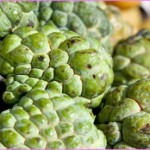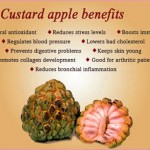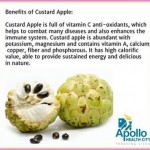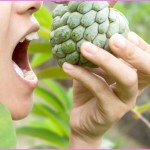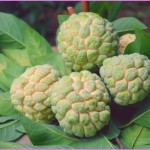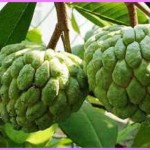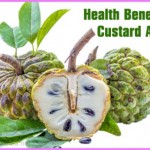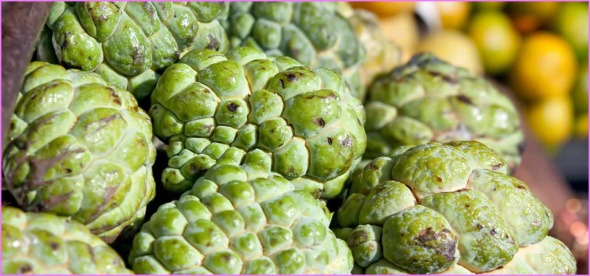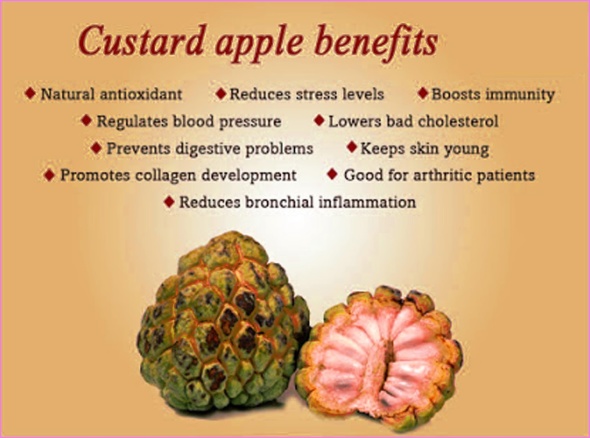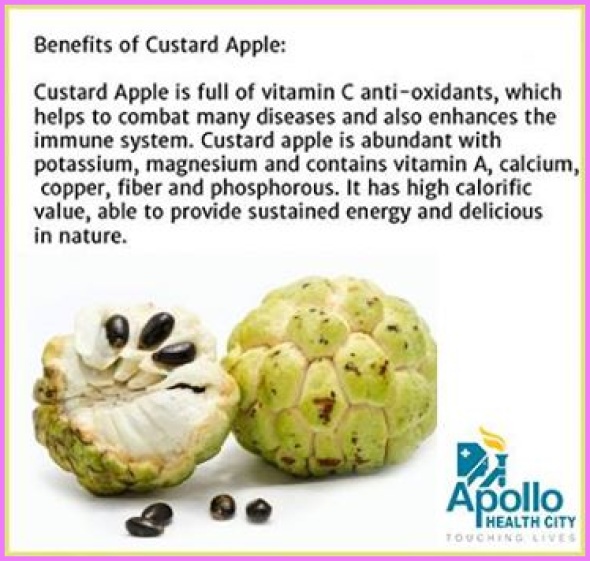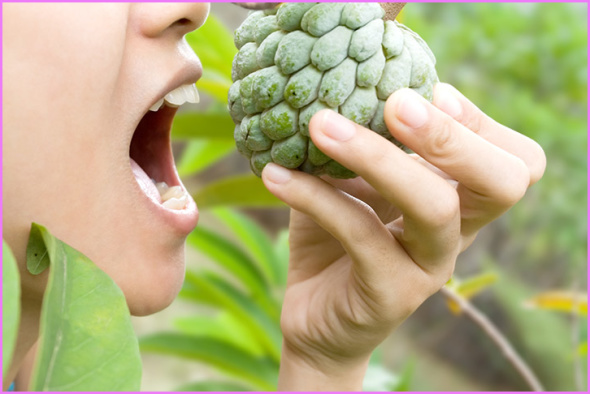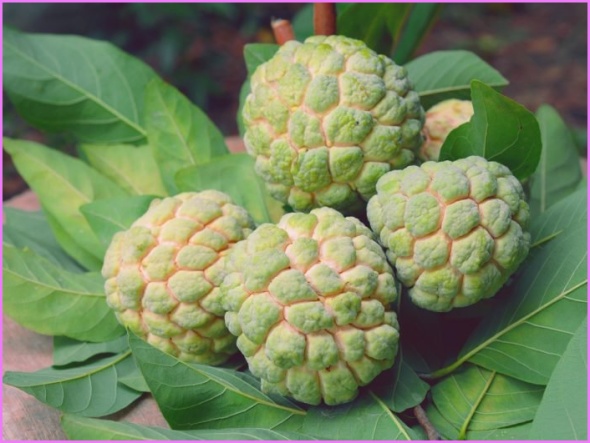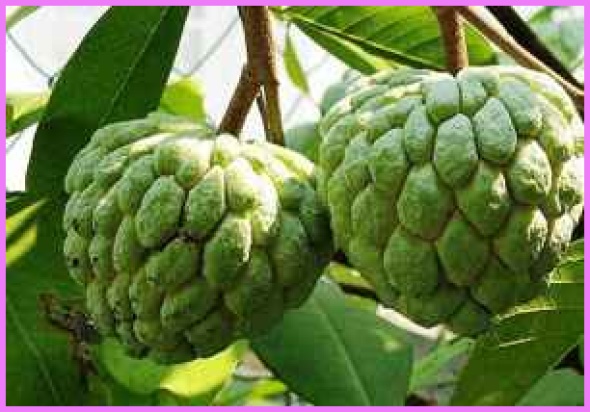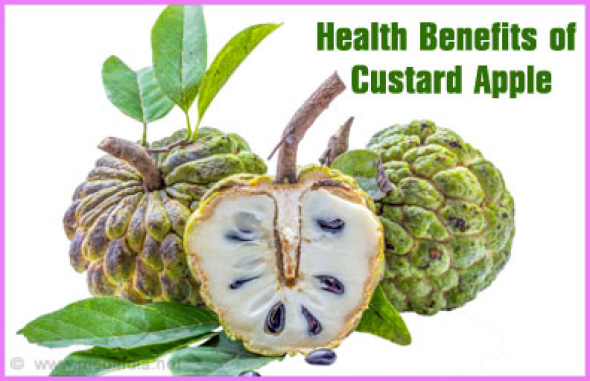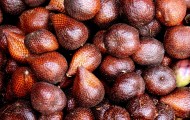Annonaceae (Custard apple family)
The pulp of custard apple is sweet and aromatic.
Description. Custard apple is a small deciduous tree, 4-10 m (13-33 ft) tall, with an open crown and spreading branches. Alternate leaves oblong, 10-20 cm (4-8 in) long by 2-7 cm (0.8-2.8 in) wide, pointed at the apex. Fragrant flowers with 3 yellowish-green and cream-colored petals are borne in small, drooping clusters of 3 or 4. Compound fruits heartshaped or of irregular shape, 8-18 cm (3-7 in) in diameter, with yellow-brown or reddish skin when ripe, with varying degree of reticulation. Pulp soft, cream-colored, sweet and aromatic, with numerous black, glossy seeds. The sweetness and aroma of the fruit depend on the variety and the individual.
Origin and Distribution. Probably native to the Caribbean and Central America, where it grows in tropical lowlands and mountains up to 1,000 m (3,300 ft). The plant spread in pre-Columbian times throughout tropical America and has become naturalized in many regions. The tree is fairly common in southern Africa and tropical Asia. The custard apple requires a tropical climate and more humid conditions than the closely related sugar apple (A. squamosa, p. 22).
Food uses. The fruit is less valued than other members of its genus, especially the sugar apple, the cherimoya (A. cherimola, p. 16), and the soursop (A. muricata, p. 19). Custard apples are usually eaten fresh, or the pulp is scooped out and made into milk shakes, ice cream, or sauces for cakes. The flesh is served with cream and sugar and eaten as dessert. Comments. The tree is sometimes used as rootstock for other Annona species. As with those other Annona species, the crushed seeds were commonly used as an insecticide to kill lice. Several parts of the plant play an important role in traditional medicine. Leaf extracts are used to treat skin infections, and leaf infusions are reputed to have a calming effect on humans. Description. Sugar apple is a small deciduous tree with an open crown and irregular branching, 3-8 m (10-26 ft) tall. Alternate leaves oblong, 6-16 cm (2.4- 6.3 in) long by 3-5 cm (1.2-2 in) wide. Fragrant flowers are produced singly or in small clusters at tips of branches. Flowers 2-4 cm (0.8-1.6 in) long with fleshy, elongated, yellowish-green petals and a dark red base. Aggregate fruits gray-green, heart-shaped, 5-12 cm (2-5 in) in diameter with numerous round protuberances. Pulp yellowish-white, soft, in conical segments. The juicy, sweet, delicious-tasting flesh contains several to many hard black or brown seeds.
Origin and Distribution. Native to tropical America, though the exact origin is unknown. The sugar apple grows naturally in warm lowlands under dry or humid conditions. Seeds of the species were brought to India by Portuguese sailors before 1590. Today it is a popular fruit throughout tropical India. Spaniards brought the fruit tree to the Philippines, from where it spread to the rest of tropical Asia and northern Australia. The sugar apple is cultivated in small-scale plantations or as a dooryard tree in most tropical and some subtropical countries.
Food uses. The pulp is eaten fresh. In parts of Asia, the strained pulp is used to flavor ice cream or to prepare milk shakes. It is important to remove the seeds before putting the pulp in an electric blender, since the crushed seeds are toxic. The pulp is processed industrially for the manufacture of desserts and ice creams.
Comments. The seeds of the sugar apple are toxic to humans when crushed and ingested. They were used by indigenous people as an insecticide to kill lice and other insects. A decoction of the leaves is used in traditional medicine of tropical America as a tonic, digestive aid, and febrifuge. This species is geographically the most widely grown Annona species.
Description. Bignay is an evergreen tree growing 3-30 m (10-100 ft) tall with a dense crown. Alternate, oblong leaves 10-25 cm (4-10 in) long by 5-8 cm (2-3 in) wide, with glossy dark green, leathery blades. Reddish male and female flowers emit a strong smell and grow on separate trees. Male flowers are borne in terminal or axillary spikes and female flowers in terminal racemes up to 25 cm (10 in) long. Round fruits measuring 6-10 mm (0.24-0.4 in) in diameter grow in long pendent clusters. Fruits ripen unevenly, so showy clusters with white, pale green, yellow, red, and almost black fruits are produced. Each fruit contains a single seed embedded in a juicy, subacid, translucent, colorless pulp that has a tart and fairly sweet flavor when fully ripe.
Origin and Distribution. Native from India to Southeast Asia and northern Australia. It is planted mainly as a dooryard tree in its area of natural distribution. Grows in tropical and subtropical climates.
Food uses. Fruits are eaten fresh but more often made into jams and jellies. Bignay is squeezed to make juice, fermented to make wine, and distilled to make brandy. In Indonesia, the ripe fruits are cooked in the preparation of fish dishes and to make a sauce for seafood. Young leaves are stewed or eaten raw with rice as a green vegetable in several parts of Southeast Asia.
Comments. Two closely related species are the Herbert River cherry (A. dallachyanum) from northern Australia, with dark red fruits, and the black currant tree (A. ghaesembilla), from Cambodia and Vietnam, which grows as a shrubby tree and produces similar dark red or dark purple fruits.
Recent studies have shown that bignay fruits are high in flavonoids and phenolic acids, making the fruit potentially important as a natural antioxidant.
Description. The peanut is an annual herbaceous plant growing 30-60 cm (12-24 in) tall. Opposite, compound leaves with 2 pairs of obtuse to broad elliptic leaflets, 2-7 cm (0.8-2.8 in) long. Flowers pealike with yellow petals and red venation. After pollination, the flower stalk elongates, bends down, and buries the developing fruit several centimeters into the soil. Seedpods with rough, light brown shells irregularly shaped, normally 3-6 cm (1.2-2.4 in) long, containing 1-4 seeds, each covered in a reddish-brown seed skin.
Origin and Distribution. Native to Bolivia and probably also indigenous to southern Peru and Paraguay. The domesticated peanut is unknown as a species in the wild. Possible progenitors are
A. ipaensis and A. duranensis. Excavations of burial sites on the Andean slopes of northern Peru have produced the oldest archaeological evidence of peanuts, dating back 7,600 years. The peanut was commonly depicted on textiles and ceramics by many South American pre-Columbian civilizations, including the Moche, Inca, and others.
Food uses. Peanuts are enjoyed raw or roasted with salt, often mixed with other nuts and seeds.
Benefits Of: CUSTARD APPLE Photo Gallery
Maybe You Like Them Too
- 5 Korean Hair Care Products To Try
- How to Remove Black Hair Dye and Restore Your Color
- Refusing To Camouflage Gray Hair At Work Reddit
- How To Stop Shampooing And Washing Hair Every Day
- How To Get Rid Of Oily Hair

